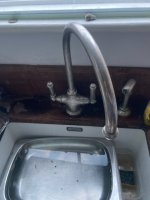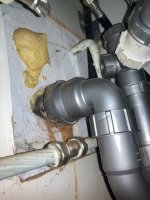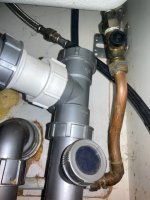Tim Brennan
Member
- Joined
- Jul 28, 2013
- Messages
- 145
14 years after we had our kitchen fitted I’m finally getting round to fixing a problem. It’s been with us since the start.
Our kitchen faucet only gives about 1.5 L per minute of flow.
About 1 foot away from the kitchen sink on the other side of the wall is an external garden tap which produces around 10 L per minute. So the problem seems to be with the plumbing rather than the mains pressure.
I started by removing the aerator at the end of the faucet. This improved the flow up to about 4 L per minute. I then looked underneath the sink to see what all valves are installed. Please see attached photos.
I don’t have a huge amount of experience with plumbing, but I can see that the ball valves are not the full bore type. That’s one thing I could potentially change, but would it give me the desired flow of about 10 L a minute? Should I be looking to swap out the aerator for a higher flow rate version? Or maybe do both of these? Or something else?
I can see other brass valves but I don’t know what these are or if these are the problem.
Our kitchen faucet only gives about 1.5 L per minute of flow.
About 1 foot away from the kitchen sink on the other side of the wall is an external garden tap which produces around 10 L per minute. So the problem seems to be with the plumbing rather than the mains pressure.
I started by removing the aerator at the end of the faucet. This improved the flow up to about 4 L per minute. I then looked underneath the sink to see what all valves are installed. Please see attached photos.
I don’t have a huge amount of experience with plumbing, but I can see that the ball valves are not the full bore type. That’s one thing I could potentially change, but would it give me the desired flow of about 10 L a minute? Should I be looking to swap out the aerator for a higher flow rate version? Or maybe do both of these? Or something else?
I can see other brass valves but I don’t know what these are or if these are the problem.



